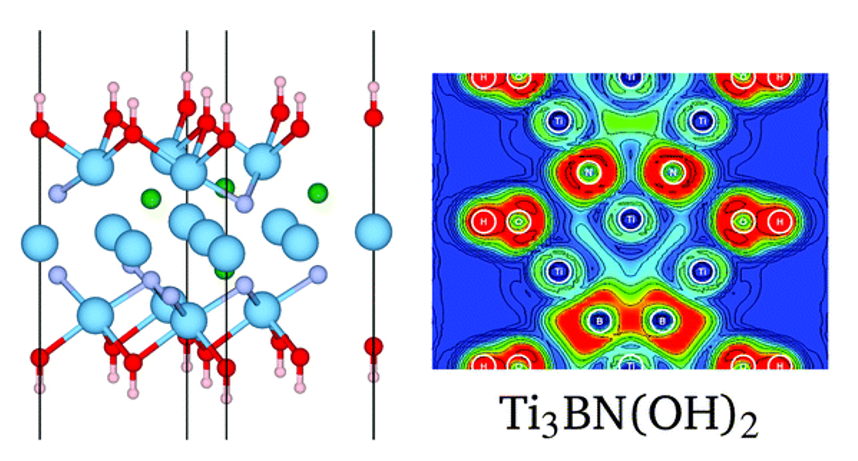
Achievement:
Researchers from Oak Ridge National Laboratory (ORNL) used high-throughput computational techniques to identify a new class of 2D nanomaterial, MXenes including boron-nitride. MXenes are highly promising materials for rechargeable metal ion batteries and supercapacitors due to their high energy storage capacities, high electrical and ionic conductivities, and ease of synthesis. MXenes are also now the largest family of 2D nanomaterials, but are primarily carbides such as Ti3C2. The team used high-throughput computational techniques to identify boron-nitride based MXenes as stable, promising alternatives. These novel MXene compounds display high lithium storage capacities (>250 mA h g−1), as well as suitability for non-lithium ion storage (Na, K, Ca, Mg), making them attractive candidates for both batteries and supercapacitors.
Significance and Impact:
MXenes are currently the largest family of 2D nanomaterials, with many more members than is practical to synthesize and perform characterization on. While prior research has largely focused on varying the metal “M” atoms, changes to the “X” site atoms, typically carbon, are in principle also possible. Using high-throughput computation we identified a thermodynamically stable set of boron-nitride based MXenes, further expanding the family, and also identifying new materials suitable for energy storage applications. Compared to the carbides, the new materials exhibit some notable differences in voltage and capacity, particularly for non-lithium ion storage. Physical properties such as the elasticity are also distinct. This class of MXenes therefore merits further theoretical and experimental investigation.
Research Details
- Developed new recipes for high throughput density functional theory (DFT) based calculations within the atomic-simulation recipes (ASR) framework.
- In support of FAIR principles, all data published using Constellation at ORNL https://doi.org/10.13139/ORNLNCCS/1871170
Facility: Calculations were performed on CADES at ORNL and at NERSC.
Sponsor/Funding: DOE BES
PI and affiliation: Paul Kent, Computational Chemistry and Nanomaterials Group, Computational Sciences and Engineering Division, ORNL
Team: Murali Gopal Muraleedharan, Paul Kent (ORNL)
Citation and DOI:
- Murali Gopal Muraleedharan and Paul R. C. Kent. Novel boron nitride MXenes as promising energy storage materials, Nanoscale, 14, 9086-9096 (2022); DOI: 10.1039/D2NR02807G
Summary:
MXenes are promising materials for rechargeable metal ion batteries and supercapacitors due to their high energy storage capacities, high electrical and ionic conductivities, and ease of synthesis. In this study, we predict the structure and properties of hitherto unexplored Ti-boron nitride MXenes (Ti3BN and Ti3BNT2 where T = F, O, OH) using high-throughput density functional theory calculations. We identify multiple stable structures exhibiting high thermodynamic and mechanical stability with B and N atoms evenly dispersed in the lattice sites. The predicted properties of the BN MXenes show remarkable similarities to their carbide counterparts, including in their metallicity, elastic constants, and cation absorption properties. Significantly, these novel MXene compounds display high lithium storage capacities (>250 mA h g−1), as well as suitability for non-lithium ion storage (Na, K, Ca, Mg), making them attractive candidates for both batteries and supercapacitors. This class of MXenes therefore merits further theoretical and experimental investigation.


